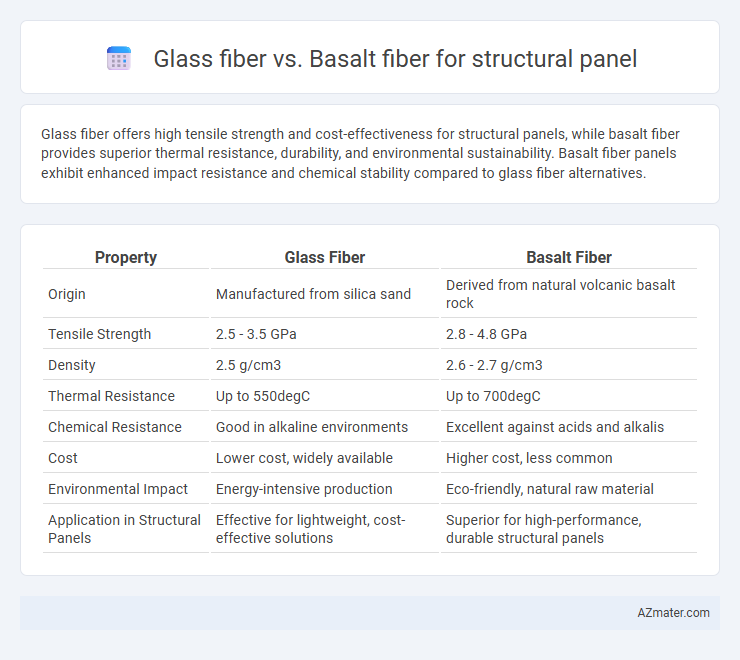Glass fiber offers high tensile strength and cost-effectiveness for structural panels, while basalt fiber provides superior thermal resistance, durability, and environmental sustainability. Basalt fiber panels exhibit enhanced impact resistance and chemical stability compared to glass fiber alternatives.
Table of Comparison
| Property | Glass Fiber | Basalt Fiber |
|---|---|---|
| Origin | Manufactured from silica sand | Derived from natural volcanic basalt rock |
| Tensile Strength | 2.5 - 3.5 GPa | 2.8 - 4.8 GPa |
| Density | 2.5 g/cm3 | 2.6 - 2.7 g/cm3 |
| Thermal Resistance | Up to 550degC | Up to 700degC |
| Chemical Resistance | Good in alkaline environments | Excellent against acids and alkalis |
| Cost | Lower cost, widely available | Higher cost, less common |
| Environmental Impact | Energy-intensive production | Eco-friendly, natural raw material |
| Application in Structural Panels | Effective for lightweight, cost-effective solutions | Superior for high-performance, durable structural panels |
Introduction to Structural Panels
Structural panels utilize advanced composite materials like glass fiber and basalt fiber to enhance strength, durability, and resistance to environmental factors. Glass fiber offers high tensile strength and lightweight properties, making it suitable for cost-effective construction applications, while basalt fiber provides superior thermal stability, corrosion resistance, and greater mechanical performance. Choosing between glass fiber and basalt fiber depends on specific structural requirements, including load-bearing capacity, exposure conditions, and longevity expectations.
Overview of Glass Fiber
Glass fiber offers high tensile strength and excellent durability, making it a popular reinforcement material for structural panels used in construction and automotive industries. Its lightweight nature combined with resistance to corrosion ensures long-term performance in various environmental conditions. Cost-effectiveness and ease of manufacturing contribute to glass fiber's widespread adoption compared to alternative fibers like basalt.
Overview of Basalt Fiber
Basalt fiber, derived from volcanic basalt rock, offers superior thermal resistance, high tensile strength, and excellent chemical stability compared to traditional glass fiber, making it an optimal choice for structural panels in demanding environments. Its natural composition provides enhanced durability, reduced environmental impact, and improved resistance to corrosion and fatigue, essential for long-term structural integrity. These properties enable basalt fiber to outperform glass fiber in applications requiring high performance and sustainability.
Mechanical Properties Comparison
Glass fiber exhibits excellent tensile strength around 2.4 GPa and good flexibility, making it a common choice for structural panels requiring durability and impact resistance. Basalt fiber offers higher tensile strength, typically 2.8-3.1 GPa, along with superior compressive strength and enhanced thermal stability, contributing to better overall mechanical performance in harsh environments. This makes basalt fiber panels more suitable for applications demanding high stiffness, improved resistance to fatigue, and elevated load-bearing capacity compared to glass fiber options.
Durability and Weather Resistance
Basalt fiber offers superior durability and weather resistance compared to glass fiber, with enhanced resistance to UV radiation, moisture, and chemical degradation, making it ideal for long-term structural panel applications. Glass fiber, while strong and cost-effective, is more susceptible to environmental factors such as alkaline substances and ultraviolet exposure, which can reduce its lifespan in outdoor conditions. Choosing basalt fiber results in structural panels with improved longevity and reliability in harsh climates, ensuring sustained performance over time.
Weight and Density Analysis
Basalt fiber exhibits a higher density of approximately 2.7-2.9 g/cm3 compared to glass fiber's density of about 2.5 g/cm3, influencing the overall weight of structural panels. Despite basalt fiber being denser, its superior mechanical properties allow for thinner panel designs that can offset weight differences. Weight analysis reveals that glass fiber panels are generally lighter but may require increased thickness to meet strength requirements, whereas basalt fiber panels offer enhanced durability with a marginal weight increase.
Cost and Manufacturing Considerations
Basalt fiber offers higher mechanical strength and thermal resistance compared to glass fiber, but the raw material cost for basalt fibers is generally higher, impacting the overall expense of structural panels. Manufacturing basalt fiber panels requires specialized equipment and higher processing temperatures, which can increase production time and energy consumption relative to glass fiber panels. Glass fiber remains more cost-effective due to its widespread availability and established manufacturing processes, making it a preferred choice for budget-sensitive structural applications.
Environmental Impact and Sustainability
Basalt fiber offers superior environmental benefits compared to glass fiber, as it is produced from natural volcanic rock with lower energy consumption and emissions during manufacturing. Basalt fiber panels exhibit enhanced recyclability and biodegradability, reducing long-term environmental impact. Glass fiber production relies heavily on energy-intensive processes and non-renewable raw materials, resulting in higher carbon footprints and less sustainable lifecycle outcomes.
Applications in Structural Panels
Basalt fiber offers superior mechanical properties and chemical resistance compared to glass fiber, making it ideal for high-performance structural panels in construction and automotive industries. Structural panels reinforced with basalt fiber provide enhanced durability, impact resistance, and thermal stability, significantly extending service life in harsh environments. Glass fiber remains cost-effective and widely used in standard structural panels but lacks the longevity and strength benefits essential for advanced engineering applications.
Conclusion: Choosing the Right Fiber
Glass fiber offers cost-effective strength and corrosion resistance, making it ideal for budget-sensitive structural panels with moderate performance needs. Basalt fiber provides superior thermal resistance, higher tensile strength, and enhanced durability under extreme conditions, best suited for high-performance and long-lasting structural applications. Selecting the right fiber depends on balancing project requirements for strength, environmental exposure, and budget constraints to ensure optimal panel performance.

Infographic: Glass fiber vs Basalt fiber for Structural panel
 azmater.com
azmater.com